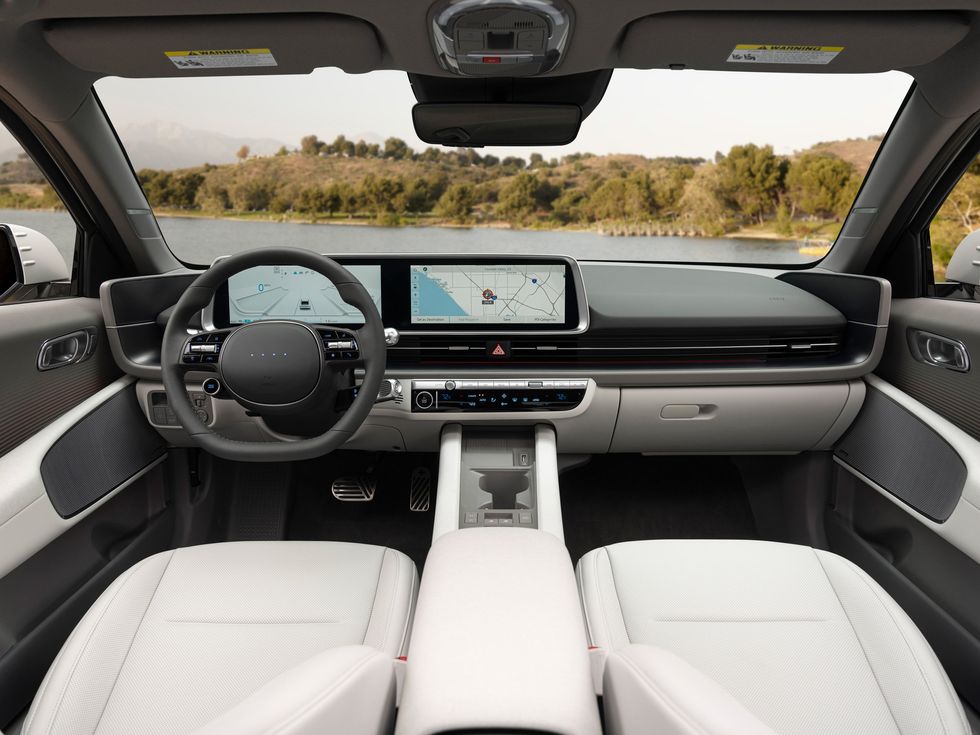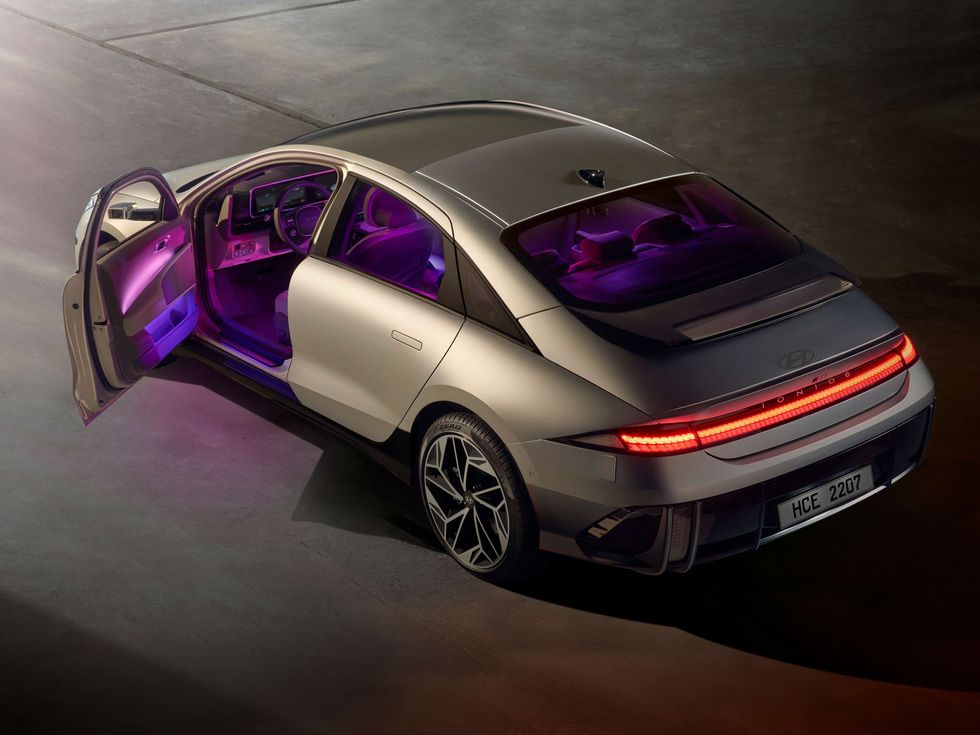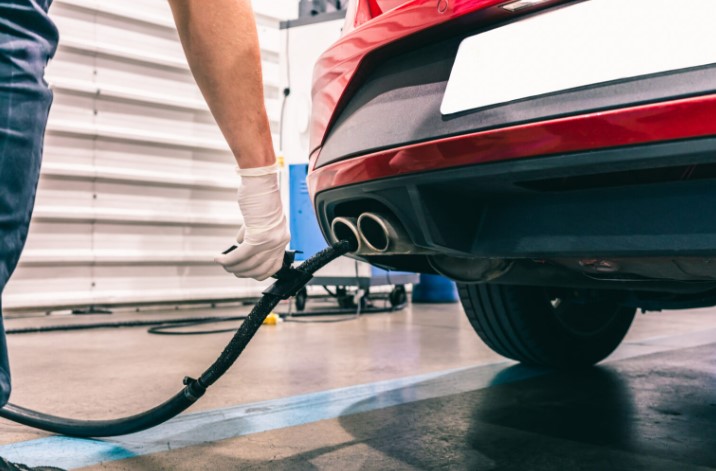Hyundai Making (Tesla) Killer EVs on the QT
In the booming business of electric cars, you expect innovation and ingenious features to hail from luxury land: Lucid, Rivian, Porsche, or Tesla.
Driving the new Hyundai Ioniq 6 sedan highlights the rise of an underdog that was almost wholly unforeseen: South Korea’s Hyundai Motors, and its Kia and luxury Genesis brands, are cranking out some of the world’s smartest-designed and technically advanced EVs, at prices actual mortals can afford.
EV price battles aside, the Ioniq 6 definitely has what it takes.
Between a slippery, aerodynamic shape and frugal powertrain, the Ioniq 6 instantly becomes the most energy-efficient EV from any mainstream brand: A 140 mpge EPA rating matches the Lucid Air Grand Touring. But the Lucid’s $139,650 price compares with $46,615 for the Hyundai’s mileage champ, an Ioniq 6 SE Long Range with a single, rear-driven electric motor. That model brings 168 kilowatts and 350 newton-meters of torque. Its maximum 580-kilometer (361-mile) driving range also gives the Ioniq 6 more road-trip stamina than any non-luxury EV. That range whips the maximum 507 km of its bullseye competitor, the Tesla Model 3 Performance. The Tesla halted production on a 576-km Model 3 Long Range, with Elon Musk citing unmanageable back orders. But the Hyundai’s 6.8 km per kWh tops even the 6.3 per kWh of Musk’s latest bait-and-switch.
I drove the Ioniq 6 on the slithering springtime roads of the Hudson Valley, barely a week after this electric sedan swept the World Car of the Year awards—for Best Car, Design, and EV—at the New York Auto Show. Ho hum: The Ioniq 5 hatchback nabbed the same awards last year.
If the Ioniq 6 is already hauling trophies, it’s also carrying some unwanted baggage: As of April 18, all Hyundai Motors EVs—including Kia and Genesis models—no longer qualify for a penny of the $7,500 consumer tax credit on electric cars. New rules under the Inflation Reduction Act seek to spur adoption of EVs, reduce greenhouse gas emissions, jump-start domestic factories and supply chains, and challenge China’s dominance in batteries and raw materials. Those rules limit buyer credits not only to EVs or plug-in hybrids built in the United States, Canada or Mexico. The rules also require a growing percentage of battery components to be sourced from North America, along with raw and processed battery minerals from the United States or approved trade partners—a list that notably does not include China or Russia.
Before the IRA was hammered out, Hyundai had publicly committed $10.5 billion toward electrification in the United States, including $5.5 billion for EV and battery factories in Savannah, Ga. Company executives have said that Hyundai and Kia, whose EVs are America’s best selling non-domestic models, should have been granted a phase-in period to earn credits before its first dedicated EV factory opens in 2025. But no dice: Hyundai is now scrambling to open that factory ahead of schedule in late 2024. Until then, its models must compete at either a $3,750 or $7,500 price handicap versus American-built EVs that earn the credits.
EV price battles aside, the Ioniq 6 definitely has what it takes.
In New York, I drove an Ioniq 6 Limited, the top-shelf version that costs $57,215 in fully loaded trim. That version is limited to 434 km, between its robust dual-motor, AWD powertrain that spins up 239 kilowatts (320 horsepower) and 607 newton-meters (448 pound-feet) of torque; and 50 cm alloy wheels with Pirelli P Zero tires that boost style and performance at the expense of driving range.
Hooked to a 350-kilowatt station, the Hyundai can add more than 100 km of range in five minutes flat.
Where the Ioniq 5 hatchback takes handsome inspiration from Giorgetto Guigiaro’s famously faceted ‘80s designs, the Ioniq 6 reaches back even farther: Hyundai designers say their “electrified streamliner” was inspired by the Stout Scarab—the Art Deco, beetle-shaped, and just bonkers proto-minivan of the 1930s.
A sleek drag coefficient of 0.22 puts the Hyundai within sight of the world’s most aerodynamic production sedan, the Mercedes EQS, another six-figure EV. Active grille shutters open to cool systems when needed, or close to reduce drag. Nifty air curtains precisely direct air through front wheel arches to soothe turbulence. Wheel-arch body cladding is sourced from recycled tires, Flush-mounted door handles pop out as you approach the car. Air flows over the bow-shaped roof to meet a natty rear spoiler that instantly recalls a Porsche 911’s whaletail. That perches above a wider decklid spoiler, both affixed with fascinating layers of crimson LEDs in Hyundai’s signature pixelated design theme. A sophisticated underbody is nearly entirely covered to further channel air and trim drag.
As with the Ioniq 5, Kia EV6, and Genesis GV70 Electrified that share its e-GMP skateboard platform, the Hyundai houses a 77.4 kWh skateboard battery pack. The Ioniq 6 advances the 5’s system with hairpin windings for its electric motors. Their rectangular wires, versus flat ones, offer several advantages: A superior fill factor in gaps to carry more current, with that improved efficiency allowing better temperature management and improving motor lifespan and reliability. Even the design is cleaner.
Versus the previous Hyundai Kona’s pack, the battery reduces parts count by 60 percent, eliminating cooling fins between modules, and boosts energy density by seven percent. Pricey silicon-carbide chips in the inverter boost driving range by five percent.
Like its stablemates, the Ioniq 6 ranks among the world’s fastest-charging EVs, with an 800-volt architecture one key to a 10-to-80 percent DC refill in a speedy 18 minutes, hitting peak rates of about 235 kilowatts. Hooked to a 350-kilowatt Electrify America station, the Hyundai can add more than 100 km of range in five minutes flat. Level 2 charging is swift as well, with a robust 10.9 kilowatt rate, versus the 7.2 kilowatts of many competitors: That brings a full battery in about seven hours.

Bi-directional charging is another tech biggie. An onboard vehicle-to-load (V2L) connector, with an included cord, lets the Hyundai charge all manners of gear at 110 volts, from e-bikes and recreational gear to tools. A company engineer said he powered a full-size refrigerator for five days with juice to spare.
The Hyundai’s teardrop silhouette stretches 16 cm beyond a Model 3, but it’s the 7.6 cm longer wheelbase that pays serious dividends inside. The dome-shaped aero roof impinges a bit on headroom—though there’s still enough for six-foot-plus passengers, front or rear. But brilliant EV packaging results in noticeably spacious hip and legroom, including 10 cm more rear legroom than a Model 3.
The steering, chassis control, and those big, grippy tires let the Hyundai hustle through curves with grace and serenity—at speeds that would challenge several highfalutin’ sports sedans.
The attractive minimalist design, fronted by a luxuriously wrapped steering wheel, features interior materials formed from recycled fishing nets and plastic bottles, and biomaterials derived from sugar cane. A cabin heat pump helps avoid using the battery to warm the cabin, saving up to 32 km of range on chillier days.
A sleek modular dashboard features a pair of 31.25 cm screens, including a touchscreen that integrates Hyundai’s overachieving infotainment system; whose navigation, apps and controls are more attractive and intuitive than those in many luxury models. Voice controls are also first-rate. Ambient lighting further recalls a Mercedes or other luxury sedan, with a choice of 64 bi-level colors. (As ever, I lean toward a Prince-like purple hue). A whimsical model adjusts ambient lighting based on vehicle speed.

On Route 9W above the Hudson River, a vertiginous route that local speedsters dub the “Cliffs of Insanity,” the Hyundai romps effortlessly past slower traffic; with adjustable levels of spacey, digitized powertrain sound that would do Kraftwerk proud. Like so many modern EVs, the Hyundai recalibrates old, fossil-fueled notions of a “family sedan,” including a sprint to 100 kph (62 mph) in less than 4.5 seconds. I dial up Sport Dynamic mode to lock the Hyundai into all-wheel-drive to maximize forward progress and confident traction. There’s more heft to the steering than in previous cars on Hyundai’s e-GMT platform, with sportier suspension tuning as well. No one will confuse the Hyundai with, say, a BMW M3, but the improved steering and chassis control—along with those big, grippy tires—let the Hyundai hustle through curves with grace and serenity, at speeds that would challenge several highfalutin’ sports sedans.
Hyundai’s signature regenerative brake system is another winner, with four selectable levels versus the one or two of many EVs; plus an adaptive mode that adjusts regen force based on radar sensing of cars up ahead: Lift off the gas on the open highway, and the Ioniq 6 will coast like a traditional car. Storm up on traffic, and the Hyundai decelerates more aggressively to match their pace. For AWD models, an electronic dog clutch can disconnect front wheels entirely when they’re not needed, or sideline them entirely in energy-saving Eco mode.
Hyundai Motors has now become the world’s third-largest automaker, its 6.8 million global sales in 2022 trailing only Toyota’s 10.5 million and Volkswagen’s 8.3 million. Driving the Ioniq 6 and its stablemates, it’s easy to see why. At the recent New York Auto Show, where the Ioniq 6 took that latest World Car crown, the company unveiled an all-new, affordable 2024 Kona EV that should start from around $36,000 when it goes on sale this fall. Not to be outdone, Kia showed off its dramatically styled EV9, which will become the U.S. market’s first mainstream, three-row electric SUV. Genesis’ GV70 Electrified, the first American-built EV from any Hyundai brand, is just arriving in showrooms—though even that Genesis doesn’t qualify for consumer tax breaks; thanks to the Korea-sourced battery pack I watched being installed on the GV70’s final workstation during the inaugural run of cars at Hyundai’s factory in Montgomery, Ala. in March. All Hyundai can do is hurry up with those new Georgia EV-and-battery factories, and consumers will have 7,500 more reasons to shop for sweet EVs like the Ioniq 6.
From Your Site Articles
Related Articles Around the Web








